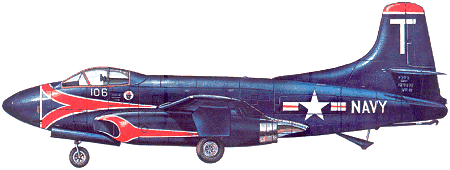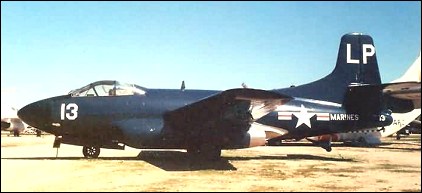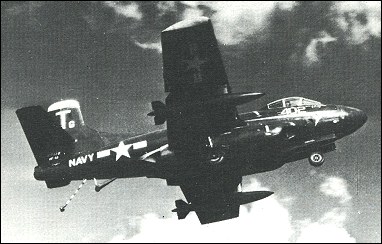|
| A US Navy requirement for a turbojet-powered carrier-based night fighter resulted in Douglas receiving a contract for three prototype aircraft in this category under the designation Douglas XF3D-1.
The type emerged as a cantilever mid-wing monoplane of all-metal construction, the wings incorporating hydraulic folding for carrier stowage. The circular-section fuselage mounted hydraulically actuated speed-brakes, provided side-by-side pressurised accommodation for the pilot and radar operator, and carried at the rear a tail unit very similar to that of the D-558-1 Skystreak. An unusual feature was a crew escape tunnel, extending from the rear of the cabin to the underside of the fuselage. Landing gear was of retractable tricycle-type, and the powerplant of the prototypes comprised
two 1361kg thrust Westinghouse J34-WE-24 turbojets, mounted on the lower edges of the forward fuselage, beneath the wing roots.
The first prototype made its maiden flight on 23 March 1948, but while company testing was still in progress an initial contract for the construction of 28 F3D-1 Skyknight production aircraft was received. The first of these was flown on 13 February 1950 and the type began to enter service in early 1951. The F3D-1 differed from the prototypes by having improved avionics and equipment and, as delivered initially, had 1361kg thrust J34-WE-32 turbojets. These engines were uprated subsequently to 1474kg thrust, becoming redesignated J34-WE-34.

Before delivery of the first F3D-1,
Douglas had received a contract for production of an improved F3D-2, which was to be the major and ultimate production version, with a total of 237 built. It was intended that the F3D-2 should be powered by 2087kg thrust J46-WE-3 turbojets, but development of this engine was abandoned and, instead, they were all powered by J34-WE-36s. Improvements included the provision of an autopilot and updated systems and equipment. The first of these F3D-2s was flown on 14 February 1951 and all had been delivered just over a year later. The Skynight saw extensive use in Korea, this all-weather fighter accounting for the majority of all victories scored by the US Navy and US Marine Corps.
F3D-1s and F3D-2s were redesignated F-10A and F-1OB respectively with introduction of the new US tri-service designation system in September 1962. Some Skyknights had been retired by 1965, but many ECM versions were operating in Vietnam until 1969.
| MODEL | F3D-2 |
| ENGINE | 2 x Westinghouse J34-WE-36/36A turbojets, 1542kg |
| WEIGHTS |
| Take-off weight | 12179 kg | 26850 lb |
| Empty weight | 8237 kg | 18160 lb |
| DIMENSIONS |
| Wingspan | 15.24 m | 50 ft 0 in |
| Length | 13.97 m | 46 ft 10 in |
| Height | 4.88 m | 16 ft 0 in |
| Wing area | 37.16 m2 | 399.99 sq ft |
| PERFORMANCE |
| Max. speed | 909 km/h | 565 mph |
| Cruise speed | 628 km/h | 390 mph |
| Ceiling | 11645 m | 38200 ft |
| Range | 1931 km | 1200 miles |
 | A three-view drawing (1663 x 1270) |
| Sal Ruggiero, e-mail, 16.11.2010 13:00 Was a plane captain and air crewman VF101 key west.1957-1958. Many good flights in the F3D. Thank god never had to slide down the chute to bail out. But we did practice alot reply | | P Detige, Beauvechain, Belgium, e-mail, 15.11.2010 20:26 I would like to see a photo of an F3D-1 reply | | Ed Fleming, e-mail, 07.11.2010 19:44 When I got out of school at Millington, I went to VMFT (AW) 20 FAHG at Cheery Point.The first time I went out on the light line, a whole ton of these big fat beauties were lined up on the flight line. Really a joy to learn on !! reply | | Howard Nickerson, e-mail, 25.10.2010 00:47 Flew the F3D with VF(AW)-3 right out of flight training in 1958. It introduced the pilot to the same radar he would operate in the F4D. reply | |
| | John Wachal, e-mail, 26.08.2010 21:35 I was a mechanic with VMCJ-1 at DaNang 69-70 and worked not only on the EF10s (Willy the Whale as we called them) but also the RF4Bs and the EA6As. reply | | Danny Walsh, e-mail, 28.08.2010 21:39 I worked on and got to fly in Willy from 1964- 1967 in VMCJ-2. Some of my best times and greatest memories. Today we have a web-site for our organization called MCARA.Please join us and pass on your memories to all who flew fixed or supported this and other great planes like the Intruder EA6A. I was one of twenty that went to Grumman in 1965 to learn this plane as they produced the first one for Viet Nam.We are trying to get the last Willy to Cherry Point or Havelock for Display. reply | | Jim Brewster, e-mail, 30.08.2010 06:54 Hi Dixon - was an RO at El Toro on the F3D from mid 1955 through end 1956. Remember Simpson very well. Remember the trips to Mojave? The runway was about 45 degrees out of line with the prevailing winds which over there could be significant - made landing a bit of fun at times - lumpy too. reply | | Pat Flannery, e-mail, 05.09.2010 13:07 When I was a kid, I had a small model of a F3D, and always liked the look of the aircraft.
When you look at it, there are ideas that are going to show up on the A-6 Intruder in later years, particularly in the way the engines are attached to the fuselage, and the side-by-side seating of the crew.
Unfortunately, it's been pretty much ignored by model manufacturers till fairly recently, when Czech Models brought out a 1 /48th scale kit of it.
An episode of the series "Dogfights" concerning night fighters has CGI of a F3D engaged in combat with a MiG-15 during the Korean War. reply | | JERRY DIXON, e-mail, 03.02.2010 08:16 Flew the Aircraft out of El Toro, VMF(AW)542 from late 1955 thru 1956 and then to VMF(AW)513, Atsugi from 1957, early 1958. First AC out of Flight Training. Was a good aircraft and very forgiving for a green pilot. Thank goodness for M /Sgt Lee Simpson, an NAP, who took me under his wing. Only had one incident out of Kadena, Okinawa. Shelled out the right engine at about two hundred feet on take off. Managed to get back around and land without too much trouble except for the lump in my pants. S /SGT Richard Long was the RO. He had the same problem. Glad to read the comments from each of you remembering a fine old AC. reply | | Fred Owlett, e-mail, 21.01.2010 22:51 I flew the F3D-2Q version with VMCJ-3 in 1958-59 out of El Toro and Iwakuni, Japan. It wasn't a real high-performance
aircraft but with its big old straight wing it could outturn a MIG-17 at 42,000 feet and with its 4 20 MM cannons, it was ready to rumble with anyone dumb enough
to try! reply | | Ron Stout, e-mail, 16.01.2010 20:43 I flew as R.O. in the F3D-2's with VMF(N)542 at El Toro and in combat in Korea with 513.I flew in the plane on a pylon at Los Alamitos and the ones in the museums at Miramar and Tucson.It was way underpowered and the J34's were prone to compressor stalls that could scare you mindless.The APQ-35 radar used vacuum tube electronics requiring lots of techs working to keep it operating.The APS radar in the tail saved my rear many times when MIGs tried to sneak up on us under ground control in North Korea.It was indeed a bitch to bail out of and some friends came to grief trying. reply | | Bill Thomas, e-mail, 08.12.2009 00:12 I was with VMCJ-2 at MCAS Cherry Point from 1963-1966. The F-10 Skynight was one of four aircraft that we serviced, the others being the RF-4B phantom, RF-8U Crusader and the EA-6A Intruder. The F-10's nickname was Willy Fudd and I can't tell you why. Other than being old it was a fine aircraft that logged many hours up and down the East Coast and in the Carribean. If any one is interested I have a couple of photos of all four aircraft in flight over C.P. reply | | Jeremy Leon, e-mail, 19.08.2008 23:16 1957 I was in VMF(AW)513 flying the F3D-2s out of Atsugi, Japan. We flew into Korea, the South CHina Sea area, and accompanied a number of U2 flights out of Atsugi heading for the mainland over Korea. Great a /c, but a bitch to get out of if you weren't straight and level. We had a great crew of ROs who did a fabulous job. Loved the a /c. reply | | Richard C Denver, e-mail, 14.06.2008 23:15 This AC was one of many that were tested on the USS Intrepid CVA 11 equiped with the first American Steam catapults. When launched from the Port cat. the cat. had a bad habit of throwing up a stream of WATER from the track
just as the shuttle reached the end. With TWO air intakes on under side of the ac it was "Flame out" befor the main
gear left the deck...
the bottom of the AC reply | |
| | Jim Perkins, e-mail, 09.06.2008 00:37 I was with VMF(n)-531 at MCAS Cherry Point, NC in 1952 when the squadron transitioned from Grumman F7F Tigercats to the F3D. I remember the training for exiting the aircraft. They would jack-up the aircraft, place mattresses underneath and the crew members would practice sliding down the chute between the pilot and radar operator's seats reply |
|
Do you have any comments?
|
| 
COMPANY
PROFILE
All the World's Rotorcraft
|









